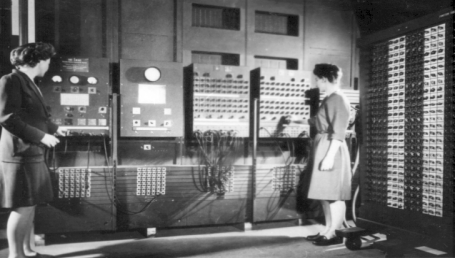|
|
Remembering Jean Bartik
By Kirk L. Kroeker
(This article appeared in
CACM, April 19, 2011.)
 Jean
Jennings Bartik, born Betty Jean Jennings in 1924, died in
Poughkeepsie, New York, on March 23, 2011 at the age of 86.
Bartik, notable to computer historians as one of the
original six programmers on the ENIAC project, received
several honors and awards in her later life to commend her
for the pioneering work she did in a nascent field that
would later be called software. Jean
Jennings Bartik, born Betty Jean Jennings in 1924, died in
Poughkeepsie, New York, on March 23, 2011 at the age of 86.
Bartik, notable to computer historians as one of the
original six programmers on the ENIAC project, received
several honors and awards in her later life to commend her
for the pioneering work she did in a nascent field that
would later be called software.
Hired as a "computer" in 1945, Bartik helped program
ENIAC (an acronym for Electronic Numerical Integrator and
Computer) to calculate artillery trajectory tables for the
U.S. Army's Ballistics Research Lab, and in 1947 headed up
the team to convert ENIAC into a stored-program computer. In
addition to programming for ENIAC, Bartik worked for Eckert
& Mauchly Computer Corporation on Binac and Univac I. Over
the course of her career, she worked in various roles in
technology—in programming, logical design, technical
editing, and support—until 1985.
Before working on ENIAC, Bartik, at age 20, joined more
than 100 women in the Army's Ballistics Research Lab project
in Philadelphia to calculate firing tables with differential
equations by hand. Recruited from that project in 1945,
Bartik was hired as one of the original six ENIAC
programmers, joining Kathleen Antonelli, Frances Holberton,
Marlyn Meltzer, Frances Spence, and Ruth Teitelbaum. Until
her death, Bartik was the last surviving member of the ENIAC
women.
By working only from hardware and logic diagrams, Bartik
and the other women taught themselves how to program ENIAC
and its 18,000 vacuum tubes through an interface of hundreds
of cables and switches spread across 40 control panels. On
February 15, 1946, the Army unveiled ENIAC to the public in
a ceremony that featured the women's successful ballistics
application, which could calculate the trajectory of an
artillery shell in some 20 seconds.
The women were not introduced at the event, and Bartik
and her fellow programmers were not publicly credited for
their work until many years later. While the ENIAC women
have been associated with the project since the publication
of the initial press photos, the women's work as programmers
was mostly an untold story. Kathy Kleiman, widely credited
as being instrumental in helping to make that story public,
began to investigate the ENIAC programmers while doing
research as a student at Harvard University in 1985.
Kleiman, now the director of policy for the Public
Interest Registry, has been producing a documentary about
the ENIAC programmers (http://www.eniacprogrammers.org),
and has gathered some 20 hours of oral history interviews
with the ENIAC women. "Jean was a powerhouse, full of ideas
and opinions, and loved to share her memories about the
early days of computing," says Kleiman. "As a personality,
she was strong, she was powerful, and she had a lot of
opinions that she shared with great conviction but also with
great humor."
Kleiman says that the primary reason the ENIAC women did
not get credit for their work was that the history of
computing, as it had been written, was a history of
hardware. "In the 1940s, when ENIAC was unveiled, the
hardware alone was mind-boggling," says Kleiman. "No one
even bothered to try to explain the software because it was
a concept that was beyond people's understanding at the
time."
As for the many awards Bartik had received, Kleiman says
they cannot erase the initial oversight, but she notes that
Bartik was thrilled, decades later, to be recognized for her
work, and enjoyed being introduced as an ENIAC pioneer. "She
was the super-pioneer; she reveled in that role in later
life," says Kleiman. "Jean Bartik's contributions to
computing are significant, and still largely undocumented."
Kleiman says still more work needs to be done in
successfully detailing that early era in the history of
computing. Kleiman is now looking for funding to complete
her documentary about the ENIAC women. "I want Jean Bartik
to be a name known to every girl and boy who studies
computing," she says. "I want her to be a role model for the
next generations. She's a real inspiration."
In 1997, Bartik was inducted into the Women in Technology
International Hall of Fame, along with the other original
ENIAC programmers. In 2008, Bartik, along with Bob Metcalfe
and Linus Torvalds, received a Fellow Award from the
Computer History Museum. In 2009, she received the IEEE
Computer Society's Computer Pioneer Award. Bartik received
an honorary doctorate in science from Northwest Missouri
State University, her alma mater, which has named a museum
after her.
Kirk L. Kroeker works in communications
and has written extensively about the impact of emerging
technologies.
|